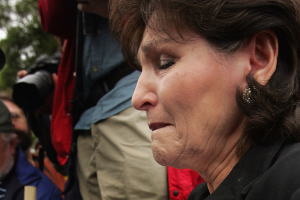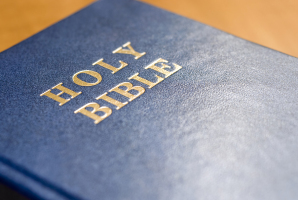Historic Jewish Temple is located 'stone's throw away' from Dome of The Rock: 'Temple Revealed' author

Contrary to the prevailing view, groundbreaking new research argues that the Dome of the Rock Islamic shrine, which sits atop the Temple Mount in Jerusalem, is not the location of the historic Jewish temple.
In his debut book, The Temple Revealed: The True Location of The Jewish Temple Hidden In Plain Sight, author Christian Widener challenges the widely-held belief about where the ancient structure was once situated. He explains in great detail why the actual site is a mere stone's throw away on the Mount. And though unbeknownst to many, biblical prophecies are being fulfilled right before our eyes.
Widener told The Christian Post’s "Life in the Kingdom" podcast that he became interested in the subject after reading various news reports and articles. As he heard specific claims that didn't make sense to him, it became a proverbial pebble in his shoe that he couldn't ignore. So, he decided to explore the topic more deliberately.
An engineer by training, he always wants to make two and two equal four, he said, “and so if something does not add up to me, it somehow calls to me, and I keep digging.”
The strongest evidence he found was when he was watching a rabbi give a tour of the East Gate in the Old City. The rabbi explained that this was the famed Messianic gate but not actually the real gate because the real gate has to be in front of the Temple, and the temple is where the Dome of the Rock is and, therefore, it could not be the real gate.
Yet Widener revisited Ezekiel 44, where the prophet records looking out at the Eastern Gate, and the LORD says that it is to remain shut, that it must not be opened and no one may enter through it because the Lord, the God of Israel, has entered through it.
“You look at a landmark like that, and you think it’s either not a real landmark because the rabbis record a lot of things in the Mishnah about Temple practices that are not in the Bible but are their best faithful recollections of Temple practices and things like that. And they’re very explicit that all of the gates in the Temple out to the outer sanctuary were in line,” Widener said.
The Mishnah is the first major written collection of Jewish oral traditions, known as the Oral Torah. It is also the first major work of rabbinic literature.
In the Israel Museum in Jerusalem, a giant Temple model as it looked during the time of Herod and Jesus likewise shows the gates aligned together, he added.
It has to be one or the other, Widener reasoned. Either the Temple is not where the Dome of the Rock is located, or the gate in question is not the real gate. As he dug deeper, he found considerable historical attestations about this, that the Golden Gate is indeed the real one.
“That’s where I kept peeling back the onion layers, and the more I looked, the more evidence I found that the Golden Gate was truly an original temple landmark and that’s then what started undoing the case” — the belief that the Temple site is where the Dome of the Rock now sits, he said.
The other major factor that led Widener to believe this was precisely where the Temple was located in the first place was because 2 Chronicles 3:1 reveals that Solomon started building the Temple on Mount Moriah on the threshing floor of Araunah the Jebusite, the place provided by David.
“A threshing floor has to be flat. It’s a place where you lay out the grain, put the threshing sledges over it to separate the wheat from the chaff and tear off the stalks. ... It’s a really common practice that you see all over Israel. And when we look at the rock in the Dome of the Rock, it’s not flat. It’s not even close to flat,” he elaborated.
As part of his investigation, he engaged Asher Kaufman’s The Temple Mount: Where is the Holy of Holies?
Kaufman points out in his book that in the Dome of the Spirits — a small dome resting on a hexagonal base on the Mount that was built in the 10th century — is an area of flat bedrock that is built into the platform (what the Dome of the Rock sits on today) and it is actually level to it.
“As an engineer, a lot of people could look at that and say, ‘Yeah, so what. So the bedrock is level with the floor there,'” Widener said.
But that doesn’t happen by accident, he stressed.
“The only way you can get bedrock level with a giant platform like that is if they actually built the platform and leveled it to the bedrock, which means that the bedrock then predates the platform because the bedrock goes all the way back to the earliest [time], back to the days of Abraham when he visited Mount Moriah before there was anything built there, because it’s part of the mountain,” Widener explained.
In other words, the landmarks are all there, “and the kicker,” he said, “is that they’re all in line.”
“It’s not some randomly located piece of flat bedrock out there. It’s directly in line, in front of the Golden Gate,” he said, adding that it's not as though people didn't know that these landmarks existed but that they did not recognize them as belonging to the Temple.
If Widener's thesis is correct, it's a profound paradigm shift, and it is conceivable that the Temple could be rebuilt and sit in its actual location.
The question then becomes how soon that might happen given the region's political dynamics, which is known for being a tinderbox of ethnic and religious conflict. This is especially the case since the Temple Mount is arguably the most bitterly contested piece of real estate on the planet.
Organizations like the Temple Institute, the Temple Mount, the Eretz Yisrael Faithful Movement and other like-minded Jewish groups have already made considerable preparations to rebuild the temple should a window of opportunity arise, the author said.
“They absolutely have all that they need. They have plans drawn. They have materials cut and prepared, very much like David did in his time before Solomon,” he said.
He believes that recent geopolitical developments in the Middle East could bring about the circumstances in which the Temple might be reconstructed, particularly the Abraham Accords, the peace agreements brokered last year between Israel and the Gulf nations of the United Arab Emirates and Bahrain.
“That is such an enormous change of wind than we’ve seen in decades. And that is changing how at least their southern partners are looking at Israel and even the Temple Mount. There are statements coming out from Islamic scholars, Sunni scholars, that are questioning, for example, whether Jerusalem truly was the furthest mosque, because that was something that came several decades after the death of Muhammad, that became the lore,” he said.
“And so was that really the case? Or did that become sort of an invented association that happened after the fact? I’m not making these arguments. Those are Islamic scholars that are making those arguments ... ‘We should let the Jews do what they do, and we have Mecca and Medina, and that’s our holy place.’”
Such a pivot in political and religious thinking is tremendous, Widener maintains, and if it continues, the Temple Mount could lessen in significance. When Jerusalem’s spiritual status is lowered in the Islamic mind, it does nothing but elevates Mecca and Medina. This might be seen more visibly if Saudi Arabia decides to sign on to the Abraham Accords.
Among the prophecies that he believes have been fulfilled in recent decades, in 1967, almost 20 years after the birth of the modern nation-state of Israel, the Jews recaptured the ancient city of Jerusalem, including the Temple Mount, in the Six-Day War. Yet, 10 days after that victory, the Jews returned the Mount to their enemies. To this day, the Jerusalem Islamic Waqf, an Islamic religious trust, controls and manages the Temple Mount's affairs.
“When you read Ezekiel 44:8, it literally says ‘instead of carrying out your duty in regard to my holy things, you put others in charge of my sanctuary,'” Widener explained.
“That definitely happened in 1967. They got control of the Temple Mount and they turned around and gave it back to the country that had just invaded them and tried to wipe them out. The holiest place on Earth for [the Jews], and I think for us, too, because it’s God who said that that place is important. And it’s important because His Word says it is.”
Ezekiel 47 describes the Temple as the place of God’s throne, where He will dwell among Israel forever. That the Jews gave up that holy site to their enemies makes no sense, he reiterated, except for the fact that it was prophesied.
“If you’re feeling like your Bible reading is not invigorated lately ... reading the Scriptures with the recognition that the things that were prophesied are beginning to happen, it will change how you read the Bible,” Widener said.




























